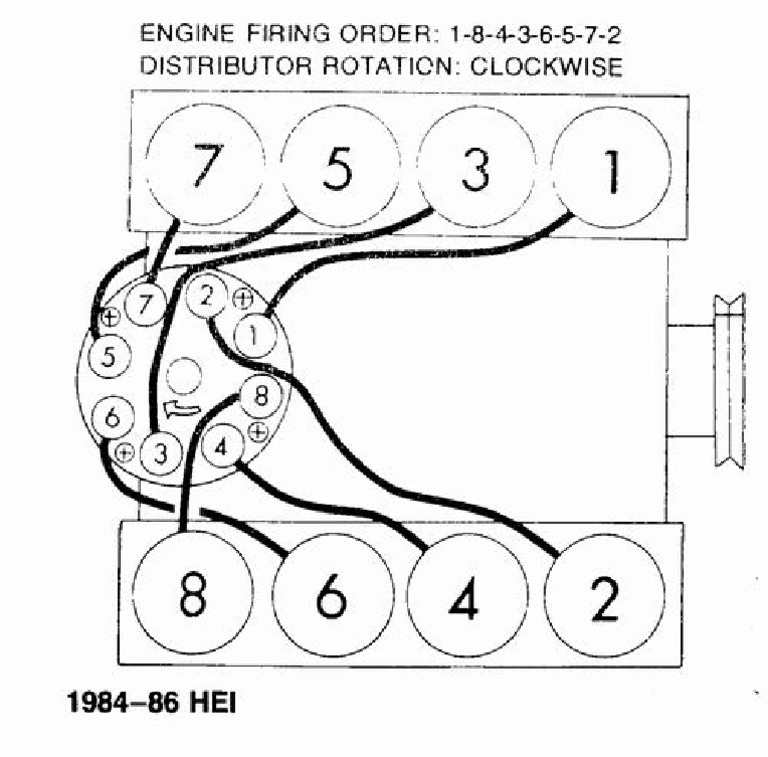When it comes to classic American muscle cars, few can ignite passion like the Corvette, particularly the 1982 model. This iconic vehicle, with its sleek lines and formidable performance, is not just a symbol of automotive excellence but also a testament to engineering prowess. However, to keep a Corvette purring like a finely-tuned instrument, regular maintenance is crucial. One essential aspect of this maintenance is understanding the firing order of the engine. This guide serves as a comprehensive overview of the 1982 Corvette firing order diagram and its significance in the world of tune-ups.
Understanding the firing order is foundational to effective engine management. In essence, the firing order refers to the sequence in which each cylinder of the engine ignites its air-fuel mixture, thereby producing the power that propels your vehicle forward. For the small-block V8 engine in the 1982 Corvette, the firing order is a crucial component in ensuring that the engine operates smoothly and efficiently.
In the 1982 Corvette, the firing order is 1-8-4-3-6-5-7-2. This order allows for an efficient distribution of power across the engine’s cylinders, minimizing vibrations and enhancing performance. By adhering to this firing order during tune-ups or repairs, owners can ensure their engines run at optimal levels, preserving the vehicle’s performance and longevity.
Everything starts with proper ignition. It involves ensuring that each cylinder fires in the correct sequence, which informs the timing of the spark and the fuel injection. An incorrect firing order can result in misfires, reduced power, and poor fuel efficiency, leading to unnecessary wear and tear on engine components. Thus, knowing the precise firing order is akin to knowing the heart of your Corvette.
When embarking on a tune-up, it’s essential first to gather all necessary materials. This generally includes a detailed firing order diagram, replacement spark plugs, ignition wires, and basic hand tools. Each of these elements plays a crucial role in achieving a successful tune-up. If you’re not familiar with the layout of the engine bay, it may help to consult your owner’s manual, which can provide insights into locating all necessary components with clarity.
Moreover, before starting the tune-up process, it’s wise to check the condition of the existing ignition system components. Old, worn-out spark plugs or damaged ignition wires can lead not only to poor performance but also to further engine complications. After extracting the old plugs, inspect them for any abnormalities such as excessive wear, carbon buildup, or signs of oil leaks. These indicators can provide vital clues about the overall health of your engine.
Once you’ve replaced any faulty parts, it’s time to focus on the firing order. The cylinder numbering for the 1982 Corvette’s small-block engine is as follows: the front cylinders are numbered 1 through 4 on the driver’s side, and 5 through 8 on the passenger side. This setup is crucial when installing new spark plug wires, as incorrect connections can create a host of issues during operation.
This is where the firing order diagram becomes invaluable. Start by installing cylinder 1’s spark plug wire to the corresponding terminal on the distributor cap. Following the firing order of 1-8-4-3-6-5-7-2, continue attaching each wire in sequence. This methodical approach prevents confusion and ensures that the engine operates smoothly from the get-go. Following the proper installation procedure not only enhances reliability but also safeguards against potential issues down the road.
Furthermore, it’s critical to pay attention to torque specifications when securing spark plugs. Too tight can strip threads, while too loose may lead to misfires. Always consult your manual for the proper torque settings and adhere to them carefully.
After completing the installation of the sparks and wires, a good practice is to conduct a visual inspection of the engine bay. Look for any signs of wear in hoses and belts, which could also affect engine performance. This holistic approach ensures that every component works in tandem, contributing to the vehicle’s overall health.
Now that your Corvette is equipped for success, it’s time to start the engine. A responsive engine should exhibit smooth idling without any irregular sounds or vibrations. If everything runs as it should, you can take pride in the knowledge that you’ve executed a thorough tune-up, giving your 1982 Corvette a new lease on life.
It’s essential to remember that tune-ups are not a one-time task but part of an ongoing maintenance regimen. Regular inspections of the ignition system and adherence to the firing order will prolong the life of your engine and enhance the driving experience. With proper care, your 1982 Corvette can deliver exciting performance for years to come.
In summary, a keen understanding of the firing order and a systematic approach to tune-ups are indispensable for every Corvette enthusiast. By following the guidelines outlined in this guide, you’re well on your way to mastering the nuances of your vehicle’s performance, ultimately preserving the spirit and excellence of the Corvette legacy.
